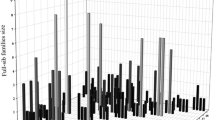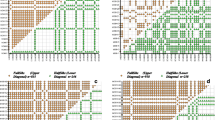Abstract
We investigated gene flow in five Cryptomeria japonica D. Don seed orchards of two different types (common and miniature) at widely spaced locations using microsatellite markers. The quality of a seed crop is determined by many factors, including pollen contamination from outside sources, self-fertilization, and the proportion of contributions from constituent clones. Contamination rates were found to vary among ramets both within seed orchards (10.0–76.7% in the most variable seed orchard) and among seed orchards (35.0–65.8% on average). Among ramets, there were significant negative correlations between pollen contamination rate and their distance from the orchard edge; among seed orchards, there were significant positive correlations between the pollen contamination rate and the C. japonica forest area nearby. Some proportion of the pollen (10.7% of total contamination) also migrated from parts of the orchards that had not been treated with gibberellin to induce flowering. Self-fertilization rates varied among seed orchards (1.4–4.4% on average), and there were significant positive correlations between self-fertilization rate and the number of ramets per clone in both types of seed orchard. Contributions as pollen donors differed significantly among clones in all seed orchards. The distance between planted ramets, flowering phenology, and relative pollen fecundity may also have contributed to observed differences in paternal contribution. The influence of these factors on genetic potential did not differ greatly between the two types of orchards.

Similar content being viewed by others
References
Adams WT, Hipkins VD, Burczyk J, Randall WK (1997) Pollen contamination trends in a maturing Douglas-fir seed orchard. Can J For Res 27:131–134
Buiteveld J, Bakker EG, Bovenschen J, de Vries SMG (2001) Paternity analysis in a seed orchard of Quercus robur L. and estimation of the amount of background pollination using microsatellite markers. For Genet 8:331–337
Burdon RD (2001) Genetic diversity and disease resistance: some considerations for research, breeding, and deployment. Can J For Res 31:596–606
El-Kassaby YA, Ritland K (1986) The relation of outcrossing and contamination to reproductive phenology and supplemental mass pollination in a Douglas-fir seed orchard. Silvae Genet 35:240–244
Erickson VJ, Adams WT (1989) Mating success in a coastal Douglas-fir seed orchard as affected by distance and floral phenology. Can J For Res 19:1248–1255
Fast W, Dancik BP (1986) Mating system and pollen contamination in a Douglas-fir clone bank. Can J For Res 16:1314–1319
Forestry Agency (1984) Studies on pollen control in seed orchards of sugi, Cryptomeria japonica D. Don. Bull For For Prod Res Inst 1984:102–159 (in Japanese)
Friedman ST, Adams WT (1985) Estimation of gene flow into two seed orchards of loblolly pine (Pinus taeda L.). Theor Appl Genet 69:609–615
Goto S, Miyahara F, Ide Y (2002) Monitoring male reproductive success in a Japanese black pine clonal seed orchard with RAPD markers. Can J For Res 32:983–988
Goto S, Miyahara F, Ide Y (2002) Identification of the male parents of half-sib progeny from Japanese black pine (Pinus thunbergii Parl.) clonal seed orchard using RAPD markers. Breed Sci 52:71–77
Hadders G, Koski V (1975) Probability of inbreeding in seed orchards. In: Faulkner R (ed) Seed orchards. Forest Commission Bulletin No. 54. Forest Commission Bulletin, London, pp 108–117
Harju A, Muona O (1989) Background pollination in Pinus sylvestris seed orchards. Scand J For Res 4:513–520
Itoo S, Katsuta M (1986) Seed productivity in the miniature clonal seed orchard of Cryptomeria japonica D. Don. J Jpn For Soc 68:284–288
Kawauchi H, Goto S (1999) Monitoring clonal management in nematode-resistant Japanese black pine seed orchard in Kagoshima Prefecture. J Jpn For Soc 81:338–340
Kusaba T (1985) Characteristics of flowering and seed production of seed orchard clones in Cryptomeria japonica D. Don. J Iwate For Prod Res Cent 18:25–42 (in Japanese)
Levinson G, Gutman GA (1987) Slipped-strand mispairing: a major mechanism for DNA sequence evolution. Mol Biol Evol 4:203–221
Longman KA, Dick JM (1981) Can seed-orchards be miniaturized? In: Proceedings of the symposium on flowering physiology, XVII IUFRO world congress, Kyoto, Japan, pp 98–102
Moriguchi Y, Iwata H, Ihara T, Yoshimura K, Taira H, Tsumura Y (2003) Development and characterization of microsatellite markers for Cryptomeria japonica D. Don. Theor Appl Genet 106:751–758
Moriguchi Y, Tani N, Taira H, Tsumura Y (2004) Variation of paternal contribution in a seed orchard of Cryptomeria japonica D. Don determined using microsatellite markers. Can J For Res 34:1683–1690
Murray M, Thompson WF (1980) Rapid isolation of high molecular weight plant DNA. Nucleic Acids Res 8:4321–4325
Nagasaka K, Tabuchi K (1975) Difference among plus tree clones for flowering ability in Cryptomeria japonica D. Don. Ann Bull Kanto For Tree Breed Inst 11:189–213 (in Japanese, with English summary)
Ohtani K, Ohba K (1983) Artificial crossing of Sugi using small isolating vinyl-frames. Ann Bull Kanto For Tree Breed Inst 15:174–179 (in Japanese, with English summary)
Pakkanen A, Nikkanen T, Pulkkinen P (2000) Annual variation in pollen contamination and outcrossing in a Picea abies seed orchard. Scand J For Res 15:399–404
Ritland K, El-Kassaby YA (1985) The nature of inbreeding in a seed orchard of Douglas fir as shown by an efficient multilocus model. Theor Appl Genet 71:375–384
Rudin D, Muona O, Yazdani R (1986) Comparison of the mating system of Pinus sylvestris in natural stands and seed orchards. Hereditas 104:15–19
Schoen DJ, Stewart SC (1986) Variation in male reproductive investment and male reproductive success in white spruce. Evolution 40:1109–1120
Shen HH, Rudin D, Lindgren D (1981) Study of the pollination pattern in a Scots pine seed orchard by means of isozyme analysis. Silvae Genet 30:7–15
Stoehr MU, Newton CH (2002) Evaluation of mating dynamics in a lodgepole pine seed orchard using chloroplast DNA markers. Can J For Res 32:469–476
Stoehr MU, Orvar BL, Gawley JR, Webber JE, Newton CH (1998) Application of a chloroplast DNA marker in seed orchard management evaluations of Douglas-fir. Can J For Res 28:187–195
Tani N, Takahashi T, Ujino-Ihara T, Iwata H, Yoshimura K, Tsumura Y (2004) Development and characteristics of microsatellite markers for sugi (Cryptomeria japonica D. Don) from microsatellite enriched libraries. Ann For Sci 61:569–575
Tsumura Y, Yoshimura K, Tomaru N, Ohba K (1995) Molecular phylogeny of conifers using RFLP analysis of PCR-amplified specific chloroplast genes. Theor Appl Genet 91:1222–1236
Wang XR, Lindgren D, Szmidt AE, Yazdani R (1991) Pollen migration into a seed orchard of Pinus sylvestris L., and the methods of its estimation using allozyme markers. Scand J For Res 6:379–385
Weir BS (1996) Genetic data analysis II. Sinauer Associates, Sunderland, MA, pp 209–211
Wheeler NC, Jech KS (1992) The use of electrophoretic markers in seed orchard research. New For 6:311–328
Yazdani R, Lindgren D (1991) Variation of pollen contamination in a Scots pine seed orchard. Silvae Genet 40:243–246
Zhu Y, Chen H, Fan J, Wang Y, Li Y, Chen J, Fan JX, Yang S, Hu L, Leung H, Mew TW, Teng PS, Wang Z, Mundt CC (2000) Genetic diversity and disease control in rice. Nature 406:718–722
Acknowledgements
The authors thank the five Prefectural Forest Experiment Stations for providing seeds for this study. We also thank S. Goto, M. Takahashi, and members of the genome analysis laboratory of the Forestry and Forest Products Research Institute for their kind advice and valuable suggestions; H. Iwata for helpful advice on statistical analysis; and K. Kashiwase and A. Miyamoto for kind help in the analysis of GIS data. We also thank T. Sugaya, Y. Takeuchi, Y. Naito, T. Takahashi, E. Yoshii, S. Tsuchiya, and members of Professor Taira’s group at Niigata University for their help in collecting seeds. We also thank the Biodiversity Center of Japan for providing vegetation maps.
Author information
Authors and Affiliations
Corresponding author
Additional information
This work was supported by grants from the Pioneer Special Studies Program of the Japanese Ministry of Agriculture, Fishery, and Forestry; the Program for Promotion of Basic Research Activities for Innovative Biosciences; and research fellowships from the Japan Society for the Promotion of Science for Young Scientists.
Rights and permissions
About this article
Cite this article
Moriguchi, Y., Tani, N., Itoo, S. et al. Gene flow and mating system in five Cryptomeria japonica D. Don seed orchards as revealed by analysis of microsatellite markers. Tree Genetics & Genomes 1, 174–183 (2005). https://doi.org/10.1007/s11295-005-0023-z
Received:
Revised:
Accepted:
Published:
Issue Date:
DOI: https://doi.org/10.1007/s11295-005-0023-z




